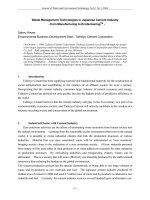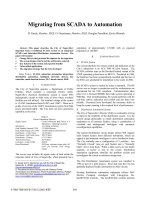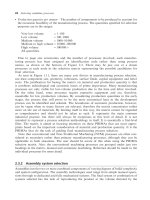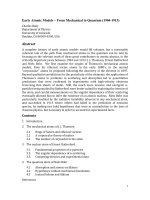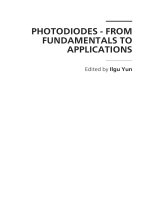- Trang chủ >>
- Khoa Học Tự Nhiên >>
- Vật lý
esposito g., marmo g., sudarshan g. from classical to quantum mechanics.. formalism, foundations, applications
Bạn đang xem bản rút gọn của tài liệu. Xem và tải ngay bản đầy đủ của tài liệu tại đây (3.08 MB, 609 trang )
From Classical to
Quantum Mechanics
This book provides a pedagogical introduction to the formalism, foundations and appli-
cations of quantum mechanics. Part I covers the basic material that is necessary to an
understanding of the transition from classical to wave mechanics. Topics include classical
dynamics, with emphasis on canonical transformations and the Hamilton–Jacobi equation;
the Cauchy problem for the wave equation, the Helmholtz equation and eikonal approxi-
mation; and introductions to spin, perturbation theory and scattering theory. The Weyl
quantization is presented in Part II, along with the postulates of quantum mechanics. The
Weyl programme provides a geometric framework for a rigorous formulation of canonical
quantization, as well as powerful tools for the analysis of problems of current interest in
quantum physics. In the chapters devoted to harmonic oscillators and angular momentum
operators, the emphasis is on algebraic and group-theoretical methods. Quantum entan-
glement, hidden-variable theories and the Bell inequalities are also discussed. Part III is
devoted to topics such as statistical mechanics and black-body radiation, Lagrangian and
phase-space formulations of quantum mechanics, and the Dirac equation.
This book is intended for use as a textbook for beginning graduate and advanced
undergraduate courses. It is self-contained and includes problems to advance the reader’s
understanding.
Giampiero Esposito received his PhD from the University of Cambridge in
1991 and has been INFN Research Fellow at Naples University since November 1993. His
research is devoted to gravitational physics and quantum theory. His main contributions
are to the boundary conditions in quantum field theory and quantum gravity via func-
tional integrals.
Giuseppe Marmo has been Professor of Theoretical Physics at Naples University
since 1986, where he is teaching the first undergraduate course in quantum mechanics.
His research interests are in the geometry of classical and quantum dynamical systems,
deformation quantization, algebraic structures in physics, and constrained and integrable
systems.
George Sudarshan has been Professor of Physics at the Department of Physics
of the University of Texas at Austin since 1969. His research has revolutionized the
understanding of classical and quantum dynamics. He has been nominated for the Nobel
Prize six times and has received many awards, including the Bose Medal in 1977.
i
ii
FROM CLASSICAL TO
QUANTUM MECHANICS
An Introduction to the Formalism, Foundations
and Applications
Giampiero Esposito, Giuseppe Marmo
INFN, Sezione di Napoli and
Dipartimento di Scienze Fisiche,
Universit`a Federico II di Napoli
George Sudarshan
Department of Physics,
University of Texas, Austin
iii
Cambridge, New York, Melbourne, Madrid, Cape Town, Singapore, São Paulo
Cambridge University Press
The Edinburgh Building, Cambridge , UK
First published in print format
- ----
- ----
© G. Esposito, G. Marmo and E. C. G. Sudarshan 2004
2004
Information on this title: www.cambrid
g
e.or
g
/9780521833240
This publication is in copyright. Subject to statutory exception and to the provision of
relevant collective licensing agreements, no reproduction of any part may take place
without the written permission of Cambridge University Press.
- ---
- ---
Cambridge University Press has no responsibility for the persistence or accuracy of s
for external or third-party internet websites referred to in this publication, and does not
guarantee that any content on such websites is, or will remain, accurate or appropriate.
Published in the United States of America by Cambridge University Press, New York
www.cambridge.org
hardback
eBook (NetLibrary)
eBook (NetLibrary)
hardback
For Michela, Patrizia, Bhamathi, and Margherita, Giuseppina, Nidia
v
vi
Contents
Preface page xiii
Acknowledgments xvi
Part I From classical to wave mechanics 1
1 Experimental foundations of quantum theory 3
1.1 The need for a quantum theory 3
1.2 Our path towards quantum theory 6
1.3 Photoelectric effect 7
1.4 Compton effect 11
1.5 Interference experiments 17
1.6 Atomic spectra and the Bohr hypotheses 22
1.7 The experiment of Franck and Hertz 26
1.8 Wave-like behaviour and the Bragg experiment 27
1.9 The experiment of Davisson and Germer 33
1.10 Position and velocity of an electron 37
1.11 Problems 41
Appendix 1.A The phase 1-form 41
2 Classical dynamics 43
2.1 Poisson brackets 44
2.2 Symplectic geometry 45
2.3 Generating functions of canonical transformations 49
2.4 Hamilton and Hamilton–Jacobi equations 59
2.5 The Hamilton principal function 61
2.6 The characteristic function 64
2.7 Hamilton equations associated with metric tensors 66
2.8 Introduction to geometrical optics 68
2.9 Problems 73
Appendix 2.A Vector fields 74
vii
viii Contents
Appendix 2.B Lie algebras and basic group theory 76
Appendix 2.C Some basic geometrical operations 80
Appendix 2.D Space–time 83
Appendix 2.E From Newton to Euler–Lagrange 83
3 Wave equations 86
3.1 The wave equation 86
3.2 Cauchy problem for the wave equation 88
3.3 Fundamental solutions 90
3.4 Symmetries of wave equations 91
3.5 Wave packets 92
3.6 Fourier analysis and dispersion relations 92
3.7 Geometrical optics from the wave equation 99
3.8 Phase and group velocity 100
3.9 The Helmholtz equation 104
3.10 Eikonal approximation for the scalar wave equation 105
3.11 Problems 114
4 Wave mechanics 115
4.1 From classical to wave mechanics 115
4.2 Uncertainty relations for position and momentum 128
4.3 Transformation properties of wave functions 131
4.4 Green kernel of the Schr¨odinger equation 136
4.5 Example of isometric non-unitary operator 142
4.6 Boundary conditions 144
4.7 Harmonic oscillator 151
4.8 JWKB solutions of the Schr¨odinger equation 155
4.9 From wave mechanics to Bohr–Sommerfeld 162
4.10 Problems 167
Appendix 4.A Glossary of functional analysis 167
Appendix 4.B JWKB approximation 172
Appendix 4.C Asymptotic expansions 174
5 Applications of wave mechanics 176
5.1 Reflection and transmission 176
5.2 Step-like potential; tunnelling effect 180
5.3 Linear potential 186
5.4 The Schr¨odinger equation in a central potential 191
5.5 Hydrogen atom 196
5.6 Introduction to angular momentum 201
5.7 Homomorphism between SU(2) and SO(3) 211
5.8 Energy bands with periodic potentials 217
5.9 Problems 220
Contents ix
Appendix 5.A Stationary phase method 221
Appendix 5.B Bessel functions 223
6 Introduction to spin 226
6.1 Stern–Gerlach experiment and electron spin 226
6.2 Wave functions with spin 230
6.3 The Pauli equation 233
6.4 Solutions of the Pauli equation 235
6.5 Landau levels 239
6.6 Problems 241
Appendix 6.A Lagrangian of a charged particle 242
Appendix 6.B Charged particle in a monopole field 242
7 Perturbation theory 244
7.1 Approximate methods for stationary states 244
7.2 Very close levels 250
7.3 Anharmonic oscillator 252
7.4 Occurrence of degeneracy 255
7.5 Stark effect 259
7.6 Zeeman effect 263
7.7 Variational method 266
7.8 Time-dependent formalism 269
7.9 Limiting cases of time-dependent theory 274
7.10 The nature of perturbative series 280
7.11 More about singular perturbations 284
7.12 Problems 293
Appendix 7.A Convergence in the strong resolvent sense 295
8 Scattering theory 297
8.1 Aims and problems of scattering theory 297
8.2 Integral equation for scattering problems 302
8.3 The Born series and potentials of the Rollnik class 305
8.4 Partial wave expansion 307
8.5 The Levinson theorem 310
8.6 Scattering from singular potentials 314
8.7 Resonances 317
8.8 Separable potential model 320
8.9 Bound states in the completeness relationship 323
8.10 Excitable potential model 324
8.11 Unitarity of the M¨oller operator 327
8.12 Quantum decay and survival amplitude 328
8.13 Problems 335
x Contents
Part II Weyl quantization and algebraic methods 337
9 Weyl quantization 339
9.1 The commutator in wave mechanics 339
9.2 Abstract version of the commutator 340
9.3 Canonical operators and the Wintner theorem 341
9.4 Canonical quantization of commutation relations 343
9.5 Weyl quantization and Weyl systems 345
9.6 The Schr¨odinger picture 347
9.7 From Weyl systems to commutation relations 348
9.8 Heisenberg representation for temporal evolution 350
9.9 Generalized uncertainty relations 351
9.10 Unitary operators and symplectic linear maps 357
9.11 On the meaning of Weyl quantization 363
9.12 The basic postulates of quantum theory 365
9.13 Problems 372
10 Harmonic oscillators and quantum optics 375
10.1 Algebraic formalism for harmonic oscillators 375
10.2 A thorough understanding of Landau levels 383
10.3 Coherent states 386
10.4 Weyl systems for coherent states 390
10.5 Two-photon coherent states 393
10.6 Problems 395
11 Angular momentum operators 398
11.1 Angular momentum: general formalism 398
11.2 Two-dimensional harmonic oscillator 406
11.3 Rotations of angular momentum operators 409
11.4 Clebsch–Gordan coefficients and the Regge map 412
11.5 Postulates of quantum mechanics with spin 416
11.6 Spin and Weyl systems 419
11.7 Monopole harmonics 420
11.8 Problems 426
12 Algebraic methods for eigenvalue problems 429
12.1 Quasi-exactly solvable operators 429
12.2 Transformation operators for the hydrogen atom 432
12.3 Darboux maps: general framework 435
12.4 SU (1, 1) structures in a central potential 438
12.5 The Runge–Lenz vector 441
12.6 Problems 443
Contents xi
13 From density matrix to geometrical phases 445
13.1 The density matrix 446
13.2 Applications of the density matrix 450
13.3 Quantum entanglement 453
13.4 Hidden variables and the Bell inequalities 455
13.5 Entangled pairs of photons 459
13.6 Production of statistical mixtures 461
13.7 Pancharatnam and Berry phases 464
13.8 The Wigner theorem and symmetries 468
13.9 A modern perspective on the Wigner theorem 472
13.10 Problems 476
Part III Selected topics 477
14 From classical to quantum statistical mechanics 479
14.1 Aims and main assumptions 480
14.2 Canonical ensemble 481
14.3 Microcanonical ensemble 482
14.4 Partition function 483
14.5 Equipartition of energy 485
14.6 Specific heats of gases and solids 486
14.7 Black-body radiation 487
14.8 Quantum models of specific heats 502
14.9 Identical particles in quantum mechanics 504
14.10 Bose–Einstein and Fermi–Dirac gases 516
14.11 Statistical derivation of the Planck formula 519
14.12 Problems 522
Appendix 14.A Towards the Planck formula 522
15 Lagrangian and phase-space formulations 526
15.1 The Schwinger formulation of quantum dynamics 526
15.2 Propagator and probability amplitude 529
15.3 Lagrangian formulation of quantum mechanics 533
15.4 Green kernel for quadratic Lagrangians 536
15.5 Quantum mechanics in phase space 541
15.6 Problems 548
Appendix 15.A The Trotter product formula 548
16 Dirac equation and no-interaction theorem 550
16.1 The Dirac equation 550
16.2 Particles in mutual interaction 554
16.3 Relativistic interacting particles. Manifest covariance 555
16.4 The no-interaction theorem in classical mechanics 556
16.5 Relativistic quantum particles 563
xii Contents
16.6 From particles to fields 564
16.7 The Kirchhoff principle, antiparticles and QFT 565
References 571
Index 588
Preface
The present manuscript represents an attempt to write a modern mono-
graph on quantum mechanics that can be useful both to expert readers,
i.e. graduate students, lecturers, research workers, and to educated read-
ers who need to be introduced to quantum theory and its foundations. For
this purpose, part I covers the basic material which is necessary to under-
stand the transition from classical to wave mechanics: the key experiments
in the development of wave mechanics; classical dynamics with empha-
sis on canonical transformations and the Hamilton–Jacobi equation; the
Cauchy problem for the wave equation, the Helmholtz equation and the
eikonal approximation; physical arguments leading to the Schr¨odinger
equation and the basic properties of the wave function; quantum dynam-
ics in one-dimensional problems and the Schr¨odinger equation in a central
potential; introduction to spin and perturbation theory; and scattering
theory. We have tried to describe in detail how one arrives at some ideas
or some mathematical results, and what has been gained by introducing
a certain concept.
Indeed, the choice of a first chapter devoted to the experimental foun-
dations of quantum theory, despite being physics-oriented, selects a set
of readers who already know the basic properties of classical mechan-
ics and classical electrodynamics. Thus, undergraduate students should
study chapter 1 more than once. Moreover, the choice of topics in chap-
ter 1 serves as a motivation, in our opinion, for studying the material
described in chapters 2 and 3, so that the transition to wave mechanics is
as smooth and ‘natural’ as possible. A broad range of topics are presented
in chapter 7, devoted to perturbation theory. Within this framework, after
some elementary examples, we have described the nature of perturbative
series, with a brief outline of the various cases of physical interest: regu-
lar perturbation theory, asymptotic perturbation theory and summabil-
ity methods, spectral concentration and singular perturbations. Chapter
xiii
xiv Preface
8 starts along the advanced lines of the end of chapter 7, and describes a
lot of important material concerning scattering from potentials.
Advanced readers can begin from chapter 9, but we still recommend
that they first study part I, which contains material useful in later inves-
tigations. The Weyl quantization is presented in chapter 9, jointly with
the postulates of the currently accepted form of quantum mechanics. The
Weyl programme provides not only a geometric framework for a rigor-
ous formulation of canonical quantization, but also powerful tools for the
analysis of problems of current interest in quantum mechanics. We have
therefore tried to present such a topic, which is still omitted in many
textbooks, in a self-contained form. In the chapters devoted to harmonic
oscillators and angular momentum operators the emphasis is on algebraic
and group-theoretical methods. The same can be said about chapter 12,
devoted to algebraic methods for the analysis of Schr¨odinger operators.
The formalism of the density matrix is developed in detail in chapter 13,
which also studies some very important topics such as quantum entangle-
ment, hidden-variable theories and Bell inequalities; how to transfer the
polarization state of a photon to another photon thanks to the projection
postulate, the production of statistical mixtures and phase in quantum
mechanics.
Part III is devoted to a number of selected topics that reflect the au-
thors’ taste and are aimed at advanced research workers: statistical me-
chanics and black-body radiation; Lagrangian and phase-space formula-
tions of quantum mechanics; the no-interaction theorem and the need for
a quantum theory of fields.
The chapters are completed by a number of useful problems, although
the main purpose of the book remains the presentation of a conceptual
framework for a better understanding of quantum mechanics. Other im-
portant topics have not been included and might, by themselves, be the
object of a separate monograph, e.g. supersymmetric quantum mechan-
ics, quaternionic quantum mechanics and deformation quantization. But
we are aware that the present version already covers much more material
than the one that can be presented in a two-semester course. The ma-
terial in chapters 9–16 can be used by students reading for a master or
Ph.D. degree.
Our monograph contains much material which, although not new by it-
self, is presented in a way that makes the presentation rather original with
respect to currently available textbooks, e.g. part I is devoted to and built
around wave mechanics only; Hamiltonian methods and the Hamilton–
Jacobi equation in chapter 2; introduction of the symbol of differential op-
erators and eikonal approximation for the scalar wave equation in chapter
3; a systematic use of the symbol in the presentation of the Schr¨odinger
equation in chapter 4; the Pauli equation with time-dependent magnetic
Preface xv
fields in chapter 6; the richness of examples in chapters 7 and 8; Weyl
quantization in chapter 9; algebraic methods for eigenvalue problems in
chapter 12; the Wigner theorem and geometrical phases in chapter 13;
and a geometrical proof of the no-interaction theorem in chapter 16.
So far we have defended, concisely, our reasons for writing yet another
book on quantum mechanics. The last word is now with the readers.
Acknowledgments
Our dear friend Eugene Saletan has kindly agreed to act as merciless
reviewer of a first draft. His dedicated efforts to assess our work have
led to several improvements, for which we are much indebted to him.
Comments by Giuseppe Bimonte, Volodya Man‘ko, Giuseppe Morandi,
Saverio Pascazio, Flora Pempinelli and Patrizia Vitale have also been
helpful.
Rosario Peluso has produced a substantial effort to realize the figures
we needed. The result shows all his skills with computer graphics and
his deep love for fundamental physics. Charo Ivan Del Genio, Gabriele
Gionti, Pietro Santorelli and Annamaria Canciello have drawn the last set
of figures, with patience and dedication. Several students, in particular
Alessandro Zampini and Dario Corsi, have discussed with us so many
parts of the manuscript that its present version would have been unlikely
without their constant feedback, while Andrea Rubano wrote notes which
proved very useful in revising the last version.
Our Italian sources have not been cited locally, to avoid making un-
helpful suggestions for readers who cannot understand textbooks written
in Italian. Here, however, we can say that we relied in part on the work
in Caldirola et al. (1982), Dell’Antonio (1996), Onofri and Destri (1996),
Sartori (1998), Picasso (2000) and Stroffolini (2001).
We are also grateful to the many other students of the University of
Naples who, in attending our lectures and asking many questions, made
us feel it was appropriate to collect our lecture notes and rewrite them
in the form of the present monograph.
Our Editor Tamsin van Essen at Cambridge University Press has pro-
vided invaluable scientific advice, while Suresh Kumar has been assisting
us with TeX well beyond the call of duty.
xvi
Part I
From classical to wave mechanics
1
Experimental foundations
of quantum theory
This chapter begins with a brief outline of some of the key motivations
for considering a quantum theory: the early attempts to determine the
spectral distribution of energy density of black bodies; stability of atoms
and molecules; specific heats of solids; interference and diffraction of
light beams; polarization of photons. The experimental foundations of
wave mechanics are then presented in detail, but in a logical order quite
different from its historical development: photo-emission of electrons by
metallic surfaces, X- and γ-ray scattering from gases, liquids and solids,
interference experiments, atomic spectra and the Bohr hypotheses, the
experiment of Franck and Hertz, the Bragg experiment, diffraction of
electrons by a crystal of nickel (Davisson and Germer), and measure-
ments of position and velocity of an electron.
1.1 The need for a quantum theory
In the second half of the nineteenth century it seemed that the laws
of classical mechanics, developed by the genius of Newton, Lagrange,
Hamilton, Jacobi and Poincar´e, the Maxwell theory of electromagnetic
phenomena and the laws of classical statistical mechanics could account
for all known physical phenomena. Still, it became gradually clear, after
several decades of experimental and theoretical work, that one has to for-
mulate a new kind of mechanics, which reduces to classical mechanics in a
suitable limit, and makes it possible to obtain a consistent description of
phenomena that cannot be understood within the classical framework. It
is now appropriate to present a brief outline of this new class of phenom-
ena, the systematic investigation of which is the object of the following
sections and of chapters 4 and 14.
(i) In his attempt to derive the law for the spectral distribution of energy
density of a body which is able to absorb all the radiant energy falling
3
4 Experimental foundations of quantum theory
upon it, Planck was led to assume that the walls of such a body consist
of harmonic oscillators, which exchange energy with the electromagnetic
field inside the body only via integer multiples of a fundamental quan-
tity ε
0
.Atthis stage, to be consistent with another law that had been
derived in a thermodynamical way and was hence of universal validity,
the quantity ε
0
turned out to be proportional to the frequency of the
radiation field, ε
0
= hν, and a new constant of nature, h, with dimension
[energy] [time] and since then called the Planck constant, was introduced
for the first time. These problems are part of the general theory of heat
radiation (Planck 1991), and we have chosen to present them in some
detail in chapter 14, which is devoted to the transition from classical to
quantum statistical mechanics.
(ii) The crisis of classical physics, however, became even more evident
when attempts were made to account for the stability of atoms and
molecules. For example, if an atomic system, initially in an equilibrium
state, is perturbed for a short time, it begins oscillating, and such os-
cillations are eventually transmitted to the electromagnetic field in its
neighbourhood, so that the frequencies of the composite system can be
observed by means of a spectrograph. In classical physics, independent
of the precise form of the forces ruling the equilibrium stage, one would
expect to be able to include the various frequencies in a scheme where
some fundamental frequencies occur jointly with their harmonics. In con-
trast, the Ritz combination principle (see section 1.6) is found to hold,
according to which all frequencies can be expressed as differences between
some spectroscopic terms, the number of which is much smaller than the
number of observed frequencies (Duck and Sudarshan 2000).
(iii) If one tries to overcome the above difficulties by postulating that the
observed frequencies correspond to internal degrees of freedom of atomic
systems, whereas the unknown laws of atomic forces forbid the occurrence
of higher order harmonics (Dirac 1958), it becomes impossible to account
for the experimental values of specific heats of solids at low temperatures
(cf. section 14.8).
(iv) Interference and diffraction patterns of light can only be accounted for
using a wave-like theory. This property is ‘dual’ to a particle-like picture,
which is instead essential to understanding the emission of electrons by
metallic surfaces that are hit by electromagnetic radiation (section 1.3)
and the scattering of light by free electrons (section 1.4).
(v) It had already been a non-trivial achievement of Einstein to show that
the energy of the electromagnetic field consists of elementary quantities
W = hν, and it was as if these quanta of energy were localized in space
1.1 The need for a quantum theory 5
(Einstein 1905). In a subsequent paper, Einstein analysed a gas com-
posed of several molecules that was able to emit or absorb radiation, and
proved that, in such processes, linear momentum should be exchanged
among the molecules, to avoid affecting the Maxwell distribution of ve-
locities (Einstein 1917). This ensures, in turn, that statistical equilibrium
is reached. Remarkably, the exchange of linear momentum cannot be ob-
tained, unless one postulates that, if spontaneous emission occurs, this
happens along a well-defined direction with corresponding vector u,so
that the linear momentum reads as
p =
W
c
u =
hν
c
u =
h
λ
u. (1.1.1)
In contrast, if a molecule were able to emit radiation along all possible
directions, as predicted by classical electromagnetic theory, the Maxwell
distribution of velocities would be violated. There was, therefore, strong
evidence that spontaneous emission is directional. Under certain circum-
stances, electromagnetic radiation behaves as if it were made of elemen-
tary quantities of energy W = hν, with speed c and linear momentum
p as in Eq. (1.1.1). One then deals with the concept of energy quanta of
the electromagnetic field, later called photons (Lewis 1926).
(vi) It is instructive, following Dirac (1958), to anticipate the description
of polarized photons in the quantum theory we are going to develop. It
is well known from experiments that the polarization of light is deeply
intertwined with its corpuscular properties, and one comes to the conclu-
sion that photons are, themselves, polarized. For example, a light beam
with linear polarization should be viewed as consisting of photons each
of which is linearly polarized in the same direction. Similarly, a light
beam with circular polarization consists of photons that are all circularly
polarized. One is thus led to say that each photon is in a given polar-
ization state. The problem arises of how to apply this new concept to
the spectral resolution of light into its polarized components, and to the
recombination of such components. For this purpose, let us consider a
light beam that passes through a tourmaline crystal, assuming that only
linearly polarized light, perpendicular to the optical axis of the crystal,
is found to emerge. According to classical electrodynamics, if the beam
is polarized perpendicularly to the optical axis O,itwill pass through
the crystal while remaining unaffected; if its polarization is parallel to
O, the light beam is instead unable to pass through the crystal; lastly, if
the polarization direction of the beam forms an angle α with O, only a
fraction sin
2
α passes through the crystal.
Let us assume, for simplicity, that the incoming beam consists of one
photon only, and that one can detect what comes out on the other side
6 Experimental foundations of quantum theory
of the crystal. We will learn that, according to quantum mechanics, in a
number of experiments the whole photon is detected on the other side of
the crystal, with energy equal to that of the incoming photon, whereas,
in other circumstances, no photon is eventually detected. When a photon
is detected, its polarization turns out to be perpendicular to the optical
axis, but under no circumstances whatsoever shall we find, on the other
side of the crystal, only a fraction of the incoming photon. However, on
repeating the experiment a sufficiently large number of times,aphoton
will eventually be detected for a number of times equal to a fraction
sin
2
α of the total number of experiments. In other words, the photon is
found to have a probability sin
2
α of passing through the tourmaline, and
a probability cos
2
α of being, instead, absorbed by the tourmaline. A deep
property, which will be the object of several sections from now on, is then
found to emerge: when a series of experiments are performed, one can only
predict a set of possible results with the corresponding probabilities.
As we will see in the rest of the chapter, the interpretation provided
by quantum mechanics requires that a photon with oblique polarization
can be viewed as being in part in a polarization state parallel to O, and
in part in a polarization state perpendicular to O.Inother words, a state
of oblique polarization results from a ‘superposition’ of polarizations that
are perpendicular and parallel to O.Itishence possible to decompose
any polarization state into two mutually orthogonal polarization states,
i.e. to express it as a superposition of such states.
Moreover, when we perform an observation, we can tell whether the
photon is polarized in a direction parallel or perpendicular to O,because
the measurement process makes the photon be in one of these two po-
larization states. Such a theoretical description requires a sudden change
from a linear superposition of polarization states (prior to measurement)
to a state where the polarization of the photon is either parallel or per-
pendicular to O (after the measurement).
Our brief outline has described many new problems that the general
reader is not expected to know already. Now that his intellectual curiosity
has been stimulated, we can begin a thorough investigation of all such
topics. The journey is not an easy one, but the effort to understand what
leads to a quantum theory will hopefully engender a better understanding
of the physical world.
1.2 Our path towards quantum theory
Unlike the historical development outlined in the previous section, our
path towards quantum theory, with emphasis on wave mechanics, will
rely on the following properties.
1.3 Photoelectric effect 7
(i) The photoelectric effect, Compton effect and interference phenom-
ena provide clear experimental evidence for the existence of photons.
‘Corpuscular’ and ‘wave’ behaviour require that we use both ‘attributes’,
therefore we need a relation between wave concepts and corpuscular con-
cepts. This is provided for photons by the Einstein identification (see
appendix 1.A)
k · dx −ω dt
=
1
¯h
p ·dx − p
0
dx
0
. (1.2.1a)
More precisely, light has a corpuscular nature that becomes evident tha-
nks to the photoelectric and Compton effects, but also a wave-like nature
as is shown by interference experiments. Although photons are massless,
one can associate to them a linear momentum p =¯h
k, and their energy
equals ¯hω = hν.
(ii) The form of the emission and absorption spectra, and the Bohr hy-
potheses (section 1.6). Experimental evidence of the existence of energy
levels (section 1.7).
(iii) The wave-like behaviour of massive particles postulated by de Broglie
(1923) and found in the experiment of Davisson and Germer (1927,diffrac-
tion of electrons by a crystal of nickel). For such particles one can perform
the de Broglie identification
p ·dx − p
0
dx
0
=¯h
k · dx −ω dt
. (1.2.1b)
It is then possible to estimate when the corpuscular or wave-like aspects
of particles are relevant in some physical processes.
1.3 Photoelectric effect
In the analysis of black-body radiation one met, for the first time, the
hypothesis of quanta: whenever matter emits or absorbs radiation, it does
so in a sequence of elementary acts, in each of which an amount of energy
ε is emitted or absorbed proportional to the frequency ν of the radiation:
ε = hν, where h is the universal constant known as Planck’s constant. We
are now going to see how the ideas developed along similar lines make
it possible to obtain a satisfactory understanding of the photoelectric
effect.
The photoelectric effect was discovered by Hertz and Hallwachs in 1887.
The effect consists of the emission of electrons from the surface of a solid
when electromagnetic radiation is incident upon it (Hughes and DuBridge
1932, DuBridge 1933, Holton 2000). The three empirical laws of such
an effect are as follows (see figures 1.1 and 1.2; the Millikan experiment
8 Experimental foundations of quantum theory
C
I
R
P
A
Fig. 1.1. The circuit used in the Millikan experiment. The energy with which
the electron leaves the surface is measured by the product of its charge with
the potential difference against which it is just able to drive itself before being
brought to rest. Millikan was careful enough to use only light for which the illu-
minated electrode was photoelectrically sensitive, but for which the surrounding
walls were not photosensitive.
V
B
A
0
V
I
C
Fig. 1.2. Variation of the photoelectric current with voltage, for given values of
the intensity.
